Karl E. Deckart
Soap Bubble Gallery: Image Twenty
German photographer and artist Karl E. Deckart is known for his thorough, precise, and beautiful work both in photography through the microscope and with macro camera systems. This gallery of interference photographs made with soap films is a testament to both Deckart's skill as a photographer and his understanding of the physical phenomena that surround our everyday lives. Presented below is soap bubble image number twenty in small format. Click on the image to download a larger version.

|
Macrophotography of thin soap films freely suspended on a 4 x 4-inch wire frame was conducted with a Linhof large-format bellows camera system utilizing 4 x 5-inch sheet film and imaged using an apo-macro Nikon large format Nikkor-AM ED 210 mm f-5.6 lens. To prepare the soap film, equal parts of water, glycerin, and dishwasher detergent are thoroughly mixed in a container until a solution containing evenly sized micelles is achieved. A freestanding film is formed by dipping the wire frame into the solution and withdrawing carefully to maintain an even film thickness and avoid disruption of material flow across the frame rails. After suspension, the film was illuminated by a reflected light source positioned a few degrees from the camera system. The light was passed through a diffusion screen to avoid bright spots and provide an even illumination across the field. No polarizers were employed in photomacrography of soap thin films. Image ©1999 by Karl E. Deckart. All rights reserved. |
Iridescent and vibrant, soap bubbles are transparent spherical liquid thin films that encapsulate air. Bubble membranes comprise tiny pockets of water inter-positioned between microscopically thin films of long-chain soap molecules. Molecular turbulence creates tiny vortices along the filmy surface, which are revealed in swirls of spiraling colors only after interplay of light upon the bubble surface. Color is produced by interference between light reflecting from the outside and inside surfaces of the soapy film. When two beams of light are in phase, spectacular shimmering iridescent colors arise, being animated by tiny whirling fluid movements of molecules within the membranes. Dependent upon the angles of reflected light, iridescent colors on the bubble surface change with viewing orientation, much like the eyes of peacocks' feathers.
BACK TO THE SOAP BUBBLE GALLERY
